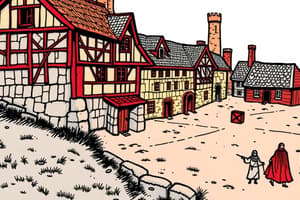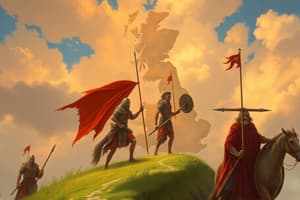Podcast
Questions and Answers
Which of the following kingdoms was NOT one of the notable Anglo-Saxon kingdoms that emerged in Britain by the 7th century?
Which of the following kingdoms was NOT one of the notable Anglo-Saxon kingdoms that emerged in Britain by the 7th century?
- Northumbria
- Scotland (correct)
- Mercia
- Wessex
The Anglo-Saxons were initially Christians upon their arrival in Britain.
The Anglo-Saxons were initially Christians upon their arrival in Britain.
False (B)
What language did the Anglo-Saxons speak?
What language did the Anglo-Saxons speak?
Old English
The process of Anglo-Saxon migration was characterized by ________ with the existing Romano-British population.
The process of Anglo-Saxon migration was characterized by ________ with the existing Romano-British population.
Match the following Anglo-Saxon kingdoms to their descriptions:
Match the following Anglo-Saxon kingdoms to their descriptions:
Which of the following was a key aspect of Anglo-Saxon law?
Which of the following was a key aspect of Anglo-Saxon law?
The Viking invasions of the 8th century had a stabilizing effect on Anglo-Saxon kingdoms.
The Viking invasions of the 8th century had a stabilizing effect on Anglo-Saxon kingdoms.
What characterized Anglo-Saxon art?
What characterized Anglo-Saxon art?
The __________ marked the end of the Anglo-Saxon period in Britain.
The __________ marked the end of the Anglo-Saxon period in Britain.
Match the following aspects of Anglo-Saxon culture with their descriptions:
Match the following aspects of Anglo-Saxon culture with their descriptions:
Flashcards
Wergild
Wergild
The practice of paying compensation for injuries or deaths, reflecting the importance of justice and order in Anglo-Saxon society.
Viking Invasions
Viking Invasions
The Viking invasions brought periods of conflict and instability to the Anglo-Saxon kingdoms.
Anglo-Saxon Art
Anglo-Saxon Art
Anglo-Saxon art exhibited intricate designs and patterns, often blending different traditions.
Anglo-Saxon Identity
Anglo-Saxon Identity
Signup and view all the flashcards
West Saxon Unification
West Saxon Unification
Signup and view all the flashcards
Who were the Anglo-Saxons?
Who were the Anglo-Saxons?
Signup and view all the flashcards
Describe the relationship between Anglo-Saxon kingdoms.
Describe the relationship between Anglo-Saxon kingdoms.
Signup and view all the flashcards
What was the social structure of Anglo-Saxon society?
What was the social structure of Anglo-Saxon society?
Signup and view all the flashcards
How did Anglo-Saxons express their culture?
How did Anglo-Saxons express their culture?
Signup and view all the flashcards
What role did Christianity play in Anglo-Saxon society?
What role did Christianity play in Anglo-Saxon society?
Signup and view all the flashcards
Study Notes
Anglo-Saxon Settlement and Migration
- The Anglo-Saxons, comprising Angles, Saxons, and Jutes, migrated to Britain during the 5th and 6th centuries CE.
- This migration followed the withdrawal of Roman forces.
- This migration significantly altered Britain's population and culture, leading to Anglo-Saxon kingdoms.
- The migration consisted of multiple waves, spurred by factors like land scarcity and warfare on the continent.
- The process was gradual, marked by conflict and interaction with the existing Romano-British population.
Anglo-Saxon Kingdoms
- Various Anglo-Saxon kingdoms, including Northumbria, Mercia, East Anglia, Wessex, and Kent, emerged by the 7th century.
- These kingdoms frequently engaged in warfare, competing for power and land.
- Political alliances formed and dissolved among these kingdoms, creating a complex power dynamic.
- Occasionally, the kingdoms united against external threats.
Anglo-Saxon Society and Culture
- Anglo-Saxon society was structured hierarchically, with kings at the top, followed by nobles, warriors, and commoners.
- The warrior class held a significant societal position, with warfare being a foundational aspect of their culture.
- Their primary economic activity was agriculture, with their society being largely agrarian.
- Strong tribal loyalties shaped their social fabric.
- Customs, traditions, and beliefs characterized their culture, including practices rooted in their rituals.
Anglo-Saxon Language and Literature
- The Anglo-Saxons spoke Old English, the precursor to modern English.
- Important examples of Old English literature include epic poems like Beowulf.
- This literature offers insights into the values and beliefs of Anglo-Saxon society.
- A substantial collection of Anglo-Saxon literature included both poetry and prose.
Anglo-Saxon Christianity
- Initially, Anglo-Saxons practiced pagan religions.
- Christianity gradually spread throughout their kingdoms, with influential figures like St. Augustine playing vital roles.
- Monasteries served as centers for learning and preservation of culture.
- Christianity influenced their laws and customs.
- Adaptation of Christianity influenced the development of Anglo-Saxon identity.
Anglo-Saxon Law and Governance
- Anglo-Saxon legal systems were intricate and differed between kingdoms.
- Laws frequently reflected local customs and practices.
- Legal frameworks aimed at resolving disputes and maintaining order, but differed based on the specific kingdom.
- The concept of wergild, a form of compensation for injuries or deaths, was a key component of their laws.
Anglo-Saxon Art and Architecture
- Anglo-Saxon art featured intricate designs and motifs.
- Surviving examples include metalwork, jewelry, and illuminated manuscripts.
- Architectural styles reflected their cultural beliefs.
- Different artistic influences blended to create a distinct Anglo-Saxon aesthetic.
The Viking Invasions and the End of the Anglo-Saxon Period
- Viking invasions, commencing in the late 8th century, posed a considerable threat to Anglo-Saxon kingdoms.
- Conflicts and political instability arose from these invasions.
- Vikings eventually established dominance and settlements.
- The unification under the West Saxons marked a pivotal point, reducing political instability and fostering centralized rule.
- The Norman Conquest in 1066 brought the Anglo-Saxon period to an end.
Studying That Suits You
Use AI to generate personalized quizzes and flashcards to suit your learning preferences.




